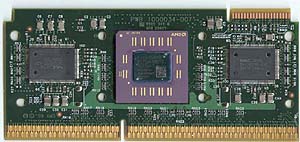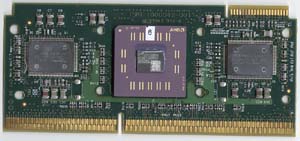0.25-micron
AMD Athlon

Click to Enlarge
0.18-micron
AMD Athlon

Click to Enlarge
Issue #2: L2 Cache Speed
Until AMD moves the L2 cache of the Athlon onto the die itself, they will have to depend on the cache manufacturers to deliver high speed L2 cache chips at a reasonable price for use with their CPUs. Intel got out of this situation after hitting the 600MHz mark with the Pentium III and Pentium III B, and, since then, all further Pentium III CPUs have featured an on-die L2 cache.
Unfortunately, the same can't be said for AMD with the Athlon. The Athlon is already at 750MHz, but it is still running with a 512KB external L2 cache that operates at a fraction of the CPU speed. Prior to the release of the 750, all Athlon CPUs ran their L2 cache at ½ the core clock speed.
The 350MHz L2 cache required for the Athlon 700 was difficult enough to come by because it required L2 cache chips with a rating faster than 3ns. In order to meet the 375MHz L2 cache requirements of a 750MHz Athlon, AMD would have to build the CPUs with 2.6ns L2 cache chips. As you can guess, this isn't too viable of an option for AMD as it would drive the prices of the 750MHz chips to unreasonably high and uncompetitive levels. So what was AMD's solution? Change the L2 cache divider.
Instead of running the L2 cache at ½ the clock speed of the CPU, the Athlon 750 runs the L2 cache at 1/2.5 or at 0.4 times the clock speed of the CPU. This 20% decrease of the L2 cache divider will definitely hurt the performance of the Athlon, in some applications more than others, but the question is how badly will it hurt the overall performance?










0 Comments
View All Comments